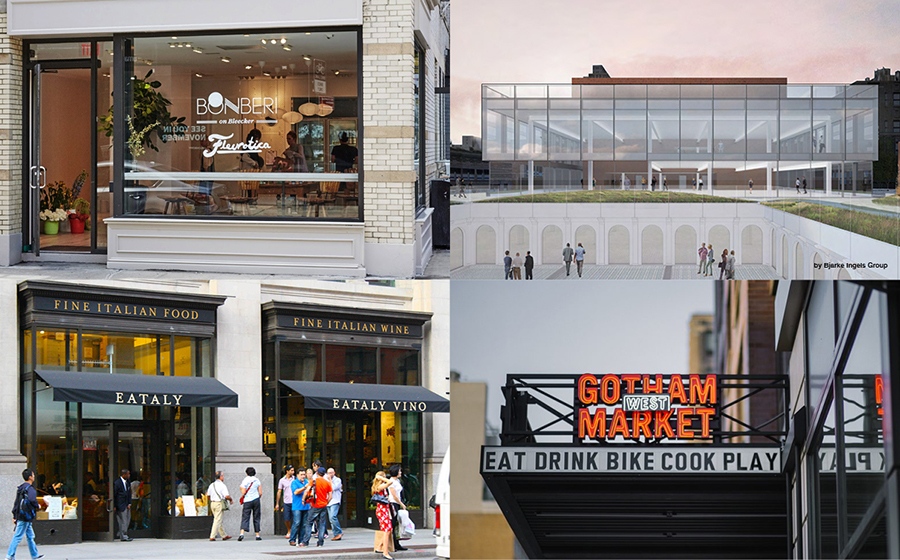It is apparent to any pedestrian strolling through midtown Manhattan that New York\’s retail real estate industry is in a state of crisis. Just count the number of long-empty storefronts along premium thoroughfares like Fifth and Madison Avenues on the East Side and Bleecker Street and environs in the West Village, and you will be overcome by a feeling of hands-up despair. So much consumer spending power . . . and yet so many spirit-killing vacancies.
What\’s Going on Here?
Clearly, a transformation of Manhattan street retail is underway. But where is it headed . . . and what will it look like five, 10, 20 years from now?
A lot depends on your definition of \”retail.\” If you understand retail to be the acquisition of stuff, then surely the abundance of abandoned storefronts in some of the prime income districts in the city is disorienting. So much discretionary income up in those pricey high rises and townhouses . . . yet so little interest in spending it at street level.
However, if you broaden that definition to include habitats for activity, enterprise and engaging experiences, the outlook improves exponentially. From this vantage point, those empty storefronts present \”opportunity zones\” for the creation of entirely new and alluring uses.
Here\’s the catch: Those uses need to generate enough sales volume to justify some of the loftiest retail rental rates in the world. Even allowing for reductions of 20 percent over the past year, rents consistently top $2,500 per square-foot in prime Manhattan locations. So, if you can\’t make it by selling $5,000 LV handbags, you need to create a dramatically higher level of sales volume – and consequently a veritable mass of consumers – to cover operating costs and generate a reasonable profit.
Mass market retailing in luxury locations? Sounds like an oxymoron . . . until you unpack its potential. Here are three recent developments that provide compelling examples of how this revolutionary new retail trend will present itself in the months and years ahead:
- Conversion of Lord & Taylor Flagship to WeWork
Hudson Bay\’s sale of its Lord & Taylor flagship on Fifth Avenue to WeWork, the collaborative office space company, represents a seismic shift for New York City retail. While L&T\’s iconic 675,000 square-foot emporium on Fifth Avenue no longer makes sense as a retail venue, it is ideally situated for a different type of commerce: the opportunity for enterprises (made up of consumers) to work, relax, imbibe refreshments and participate in beer-driven Friday receptions. And WeWork sells office and meeting space by the month, day, even the hour – along with its famed experiential amenities. A new retail venture for WeWork citizens is in the works. Is this business or commerce? That blurred line is at the very heart of the definition of the \”new retail.\” - Brookfield\’s Acquisition of Multiple Bleecker Street Storefronts
Brookfield, the renowned shopping center proprietor (and owner of Brookfield Place at New York\’s World Trade Center) has made a $32 million bet on a strip of semi-contiguous empty storefronts on the West Village\’s once-fabled Bleecker Street. The initiative, dubbed \”Love, Bleecker,\” is conceived as an incubator for quirky and intriguing entrepreneurs in the mold of the famed Magnolia Bakery (still a nearby resident). Brookfield wins two ways: activating the potential of retail space in a prime-rent district and capitalizing on successful tenants as prospective occupants of its malls and mixed-use developments throughout North America. Residents of the West Village – and by extension New York City — benefit through the rejuvenation of the formerly derelict Bleecker Street corridor and access to a fleet of distinctive and intriguing retail options at their doorsteps. - The Food Hall-ization of Manhattan
What provides a premium experience at mass volume levels better than a food hall? And vacant retail spaces in pricey, high-density neighborhoods are rapidly transforming into large-scale dining, tasting and take-out emporiums. The model and progenitor of this rapidly accelerating trend is Eataly, Mario Batali\’s reinvention of retail space in the former Toy Center building in the Flatiron District (literally facing the Flatiron Building). Enter at any hour of the day or early evening and you will be swept through by a human tide purchasing everything from a demitasse of espresso to a bushel of apples.
Other landlords have taken note – and thus the introduction of food halls with both larger and smaller footprints throughout Manhattan. Standouts among these include: The Pennsy, adjacent to Penn Station and Madison Square Garden, and packed all day long with office workers and at night with sports fans at its expansive bar and seating areas; Gotham West Market, which has activated the formerly retail challenged Hell\’s Kitchen neighborhood with a cross-section of enticing ethnic eateries, and City Acres Market which provides a coterie of epicurean dining options in the rapidly evolving residential scene of New York\’s Financial District.
One thing is certain: We will never return to those glory days of Manhattan retail when a fleet of luxury designers lined New York City\’s most distinguished thoroughfares. However, many of those neighborhoods – especially the West Village and Upper East Side – lack an adequate supply of clean and appetizing food markets, affordable dining options and comfortable places to work.
Perhaps the \”new retail\” is actually the \”old retail\” dressed up in a new disguise: a range of essential services recreated for both residents and visitors seeking a lively, personalized and definitely unwired experience in a clamorous and frenetic city.



